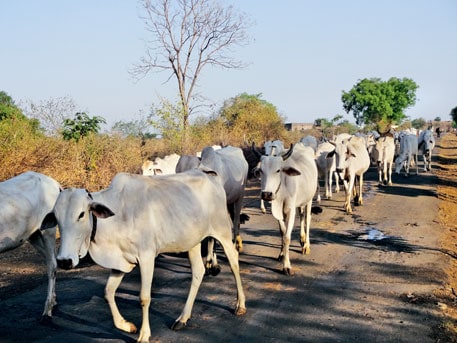
Brucellosis in Animals
Brucellosis is a contagious bacterial disease of ruminants but it also affects humans, so it is a zoonotic important disease-causing severe impact on human health.
Causitive Agent : Brucella abortus, Brucella melitensis. Brucella suis.
Mode of transmission: Ingestion, inhalitation, through the conjunctiva, through intact skin, through coitus and through infected semen.
How do animal get Brucellosis: In animals, Brucella are usually spread through contact with contaminated birthing tissues and fluids (ex. Placenta, aborted fetus, fetal fluides, vaginal discharge and the pastures contaminated due to such things, etc) and contaminated semen.
How human get Brucellosis: By contact with infected birthing tissues like placenta, aborted fetus, fetal fluids, and vaginal fluids. Generally, veterinarians are found at more risk while treating such animals. Even the microbiologists or technicians working in the laboratory, if carelessly handling the infected material may get infection. (so some policy should be framed for veterinarians, similarly, farmers or oweners and workers at abattoir are also vulnerable to infection as they handle infected animals.). Consumption of unpasturised or raw milk, ice cream,butter and cheese, animal products and byproducts coming from infected animals. slaughterhouse workers can inhale the bacteria. Persons having cuts or wounds should avoid contact of infected animals or material.
Symptoms in humans: Fever, cold, loss of appetite, weakness, headache, sometimes sweats, joint pains, muscle pains and back pains etc.
Species Affected: Cattle, sheep, goats, pigs, camels and wild animals like deer, wild hogs, Elk, Bison, Moose, Dogs and (human)
Clinical symptoms in animals: Fever. loss of appetite, uneasyness, Abortion between 4 to 9 months in cattle, in sheep late abortions or stillbirths, repeat breeding and infertility.
Public health risk : Brucellosis is a zoonosis highly infectious for humans causing a disease often called undulant fever or Malta fever
Post Mortum findings: Lesions in females – abortion, placetitis, retension of placenta, necrosis of cotyledons, leathery and opaque cotyledons may be seen. In bull- Epididymitis, orchitis, hygroma of the knee.
Diagnosis: 1) Examination of smears from abomasal contents, spleen. lungs, and heart blood from aborted foetus.
2) Examination of smears from placenta-cotyledons and urine fluid
3) Serological Test after 21 days of abortion. Serum agglutination test is a diagnostic method.
4) An ELISA has been developed to detect antibodies in milk and serum
Material to be collected: a) From aborted animals
- Cervical and vaginal discharge on ice
- Piece of placenta and two or three cotyledons on ice.
- Serum sample on day of abortion and after 21 days of abortion.
- From dead animals / from aborted fetus
- Abomasal contents on ice.
- Heart blood, and pieces of lung, liver, spleen on ice.
Differential Tests: 1) Examination of smears from abomasal contents, lungs, liver, spleen.
2) Isolation and identification of organism.
3) Serological Tests i.e. QPAT and STAT
Treatment: Treatment is not economical. It requires more weeks or even more months also. Death due to brucellosis are rare (1 %- 2% ). Generally, doxycycline and rifampin are recommended.
Prophylaxis: 1) Testing of all animals by S.T.A.T.
2 ) Removal of positive reactors.
3) Hygienic disposal of afterbirths.
4) Calves should be taken away from other animals.
5) Calf hood vaccination should be carried out if positive reactors are more than 10% and only female calves should be vaccinated at 3 to 5 months of age. The vaccine is live and must be administered only by an accredited veterinarian.
| Dr. V. M. Bhuktar
Former I/c Joint Commissioner of A.H, D, I, S. Government of Maharashtra, Former Chairman disciplinary committee VCI New Delhi. |
Dr. K. R. Shingal
Former Regional Joint Commissioner of Animal Husbandary, |
Dr. D. M. Chavan
Retd. Additional Commissioner of A.H. (M.S.) |
